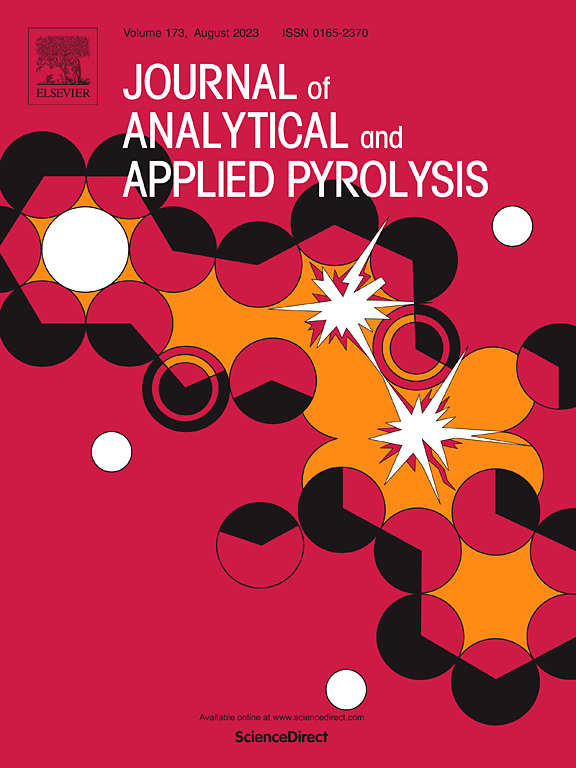十溴联苯醚的降解机理:与活性自由基的反应及多溴二苯并对二恶英和二苯并呋喃的形成化学
IF 5.8
2区 化学
Q1 CHEMISTRY, ANALYTICAL
引用次数: 0
摘要
虽然十溴联苯醚(BDE-209)作为溴化阻燃剂已被禁止生产和使用,但其对人类和生态环境的威胁仍然不容忽视。然而,BDE-209在热化学分解过程中由活性自由基引发的机理尚不清楚。采用密度泛函理论方法研究了BDE-209的热化学分解行为,自由基反应反应,以及多溴化二苯并对二恶英和二苯并呋喃(PBDD/Fs)的生成机理。结果表明,BDE-209具有较高的键离解能(249.6 ~ 281.4 kJ/mol)和HOMO-LUMO能隙(7.10 eV),不易发生自分解。BDE-209与•H、Br•和•OH三种活性自由基反应,通常在低反应能垒(52.9、54.3、50.4 kJ/mol)下生成多种低溴化产物或重要中间体。600 K时,•H与BDE-209反应体系中抽氢反应的支化率为67.5 %。在300 K下,BDE-209与Br•生成P2和IM2的反应速率常数为4.14 × 10−17 cm3分子−1 s−1。在400 K时,BDE-209 + •OH→P9 + Br•的支化率为40.3 %。BDE-209的oh -加成和oh -萃取反应生成八溴二苯并对二恶英,其进一步脱溴生成pbdd。邻苯基自由基是PBDD/Fs形成的重要前体自由基。邻苯基自由基后续降解最有利的反应途径是IM10→TS38→IM13。高分子材料的参与增加了有毒PBDD/Fs的产生。这是因为聚合物的断链形成的自由基很容易将BDE-209的邻溴原子萃取出来,从而促进PBDD/Fs前体(邻苯基自由基)的形成。进一步探讨活性自由基诱导BDE-209的降解机制,以帮助控制热处理过程中有毒物质的形成。本文章由计算机程序翻译,如有差异,请以英文原文为准。
Degradation mechanism of decabromodiphenyl ether: Reaction with reactive radicals and formation chemistry of polybrominated dibenzo-p-dioxins and dibenzofurans
Although decabromodiphenyl ether (BDE-209) has been banned from production and use as a brominated flame retardant, its threat to human and ecological environment cannot still be ignored. Nevertheless, the mechanism of BDE-209 initiated by reactive radicals in the thermochemical decomposition process remains unknown. The density functional theory method is used to study the thermochemical decomposition behavior of BDE-209, with reactive radical reactions, and the formation mechanism of polybrominated dibenzo-p-dioxins and dibenzofurans (PBDD/Fs). The results show that BDE-209 is not prone to self-decomposition due to its high bond dissociation energy (249.6 ∼ 281.4 kJ/mol) and HOMO-LUMO energy gap (7.10 eV). The reaction of BDE-209 with three active free radicals, including •H, Br•, and •OH, usually results in a variety of hypobromated products or important intermediates at low reaction energy barriers (52.9, 54.3, 50.4 kJ/mol). At 600 K, the branching ratio of H-abstraction reaction in the reaction system of •H and BDE-209 is 67.5 %. At 300 K, the reaction rate constant of BDE-209 with Br• to form P2 and IM2 is 4.14 × 10−17 cm3 molecule−1 s−1. The branching ratio of BDE-209 + •OH → P9 + Br• is 40.3 % at 400 K. The OH-addition and OH-abstraction reactions of BDE-209 form octabromodibenzo-p-dioxin, which is further debrominated to form PBDDs. Ortho-phenyl-type radical generated by eliminating ortho-Br is a crucial precursor radical for the formation of PBDD/Fs. The most favorable reaction pathway for the subsequent degradation of ortho-phenyl-type radical is IM10 → TS38 → IM13. The participation of polymer materials increases the production of toxic PBDD/Fs. This is because the free radicals formed by the chain scission of the polymer can easily extract the ortho-Br atom of BDE-209, thereby promoting the formation of the precursor (ortho-phenyl radical) of PBDD/Fs. Furthermore, the degradation mechanism of BDE-209 induced by active free radicals is explored to help control the formation of toxic substances during thermal treatment.
求助全文
通过发布文献求助,成功后即可免费获取论文全文。
去求助
来源期刊
CiteScore
9.10
自引率
11.70%
发文量
340
审稿时长
44 days
期刊介绍:
The Journal of Analytical and Applied Pyrolysis (JAAP) is devoted to the publication of papers dealing with innovative applications of pyrolysis processes, the characterization of products related to pyrolysis reactions, and investigations of reaction mechanism. To be considered by JAAP, a manuscript should present significant progress in these topics. The novelty must be satisfactorily argued in the cover letter. A manuscript with a cover letter to the editor not addressing the novelty is likely to be rejected without review.

 求助内容:
求助内容: 应助结果提醒方式:
应助结果提醒方式:


